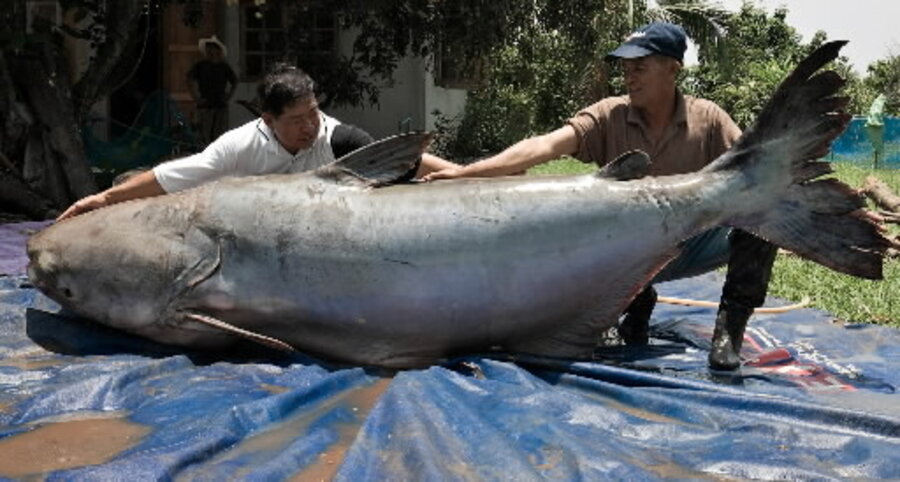Rare giant catfish faces new threat in Southeast Asia's Mekong
Loading...
The Giant Catfish is an enormous fish with thin, down-turned lips that give it a lonely look. And such a "mournful" visage is not unwarranted.
Already one of the most endangered fish in the world, a new study has found that a dam under way in Laos could push it to extinction.
So rare that it is nearly a legend of the Mekong River’s depths, the Giant Catfish belongs to the shark catfish family and reach more than 600 pounds and some 10 feet in length. The Brobdingnagian fish has dwindled in number an estimated 90 percent over the past 20 years – possibly to just a few hundred animals, though tracking the elusive fish is difficult. It is now found only in the lower Mekong, which runs like a mud-colored vein carrying the economic lifeblood of Southeast Asia through Laos, Myanmar, Thailand, Cambodia, and Vietnam. In recent years, though, progress had been made in rescuing Giant Catfish fish from extinction, as those five countries introduced new protections that banned fishing it.
Now, Laos's controversial Xayaburi Dam threatens to undo that.
“The Giant Catfish is endangered, but there’s still a chance for it, and all the countries involved have gotten on board to restrict fishing – but just when we solved one problem we’re now facing this new one,” says Zeb Hogan, the study’s author and associate research professor at the University of Nevada, in a telephone interview.
The Xayabari, the first dam in the lower Mekong, will, if finished, block the Giant Catfish from making its lifecycle migration from the floodplain rearing areas to upstream spawning sites in northern Laos and Thailand, the study said. The dam could also alter Mekong flows, disrupting the natural cues the fish needs to spawn.
This is not the first warning that the Xayabari project could mean the end for the Giant Catfish. Two years ago, the Mekong River Commission – an advisory body established in 1995 as part of an agreement between five Southeast Asian countries on the development of the Mekong – convened a panel of experts who concluded that the dam would obstruct the migrations of some 23 to 100 species of fish, including the Great Catfish. The panel recommended a 10-year hold on the Xayaburi project, pending more information on how the dam would affect the river’s ecology.
"The gaps in knowledge on the number of migratory fish species, their biomass and their ability to successfully pass a dam and reservoir leads to considerable uncertainty about the scale of impact on fisheries and associated livelihoods, both locally and in a transboundary context," the report said.
But in November 2012, Laos officially began what is expected to be seven years of construction of the Xayabari Dam, the first in several controversial dams planned for the lower Mekong.
Damming the river and preventing the fish of the Mekong from spawning could do catastrophic damage to the villages that hug the Mekong’s curls and swoops, crippling the fisheries on which those settlements depend. “It’s not just about the catfish – that same concern is general to all Mekong fisheries,” says Dr. Hogan. “The Mekong is incredibly important to people’s livelihoods, and it’s important not to make decisions about the Mekong lightly."
Pöyry, the Finnish firm advising Laos on the dam construction, has said that the dam can be equipped with passages that will let fish slip safely past the dam’s turbines, the WFF reported.
But equipping the dam to accommodate all the varieties of fish trying to slip through could be impossible, especially when the habits of most of the Mekong’s fish are so understudied and poorly understood, says Hogan. And devising a passage that can allow a fish of the Giant Catfish’s mammoth size to pass through will be all the more challenging, he said, noting that fish passageways used elsewhere in the world to help salmon have not been entirely successful at ferrying those fish, which are small relative to the Mekong’s catfish, through a dam’s turbines.
The Mekong River Commission's 2011 report had also found that there was "no certainty that fish-passage facilities will be sufficiently effective."
As an alternative to the project, scientists have proposed that the dam be placed not on the mainstream of the lower Mekong, but on one of its tributaries. In 2012, a paper published in the Proceedings of the National Academy of Sciences suggested that a specific combination of tributary dams could provide a substantial portion of the energy that the current arrangement of proposed lower Mekong dams would offer, while cutting the fish stock by only about 4 percent. Balanced against the economic blow that pending dams could do to Southeast Asia's vital fishing industry, those somewhat less powerful tributary dams become an attractive option, it said.
Overall, that report concluded, the lower Mekong’s planned dams are being built without a comprehensive analysis of their cost-benefits and of possible alternatives.
Laos, which has sorely lagged in development behind its neighbors, has said the dam is a badly needed source of energy for the country, describing the hydropower as a green alternative for its energy needs. Laos also plans to use Xayabari as regional economic leverage, selling about 90 percent of the 1.26 gigawatt-hydropower the dam will provide to its neighbors.
“We don't want to be poor any more," Viraphone Viravong, director general of the Laos’ energy and mines department, told The Guardian in 2010. "If we want to grow, we need this dam."








